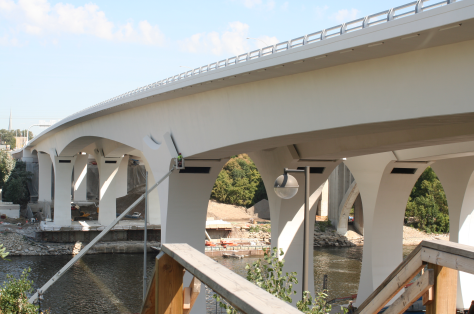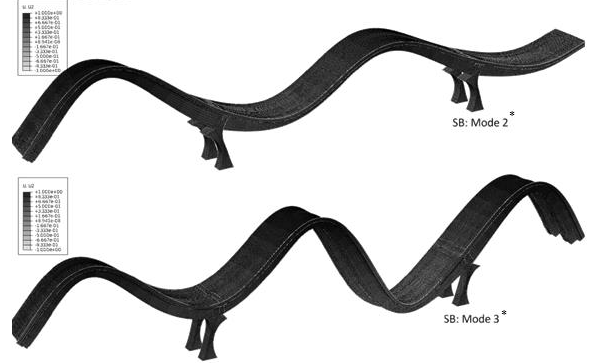By analyzing vibration data from the I-35W St. Anthony Falls Bridge, MnDOT is working to develop monitoring systems that could detect structural defects early on and ultimately allow engineers to improve bridge designs.
“With data spanning several years, the I-35W St. Anthony Falls Bridge offers a unique opportunity for investigating the environmental effects on a new concrete bridge in a location with weather extremes,” said Lauren Linderman, Assistant Professor, University of Minnesota Department of Civil, Environmental and Geo-Engineering. Linderman served as the research project’s principal investigator.
“This project gets MnDOT closer to using bridge monitoring systems in combination with visual inspection to help detect structural problems before they affect safety or require expensive repairs,” said Benjamin Jilk, Principal Engineer, MnDOT Bridge Office. Jilk served as the research project’s technical liaison.

What Was the Need?
In September 2008, the I-35W St. Anthony Falls Bridge was constructed to include a “smart bridge” electronic monitoring system. This system includes more than 500 sensors that continuously provide data on how the concrete structure bends and deforms in response to traffic loads, wind and temperature changes. Transportation agencies are increasingly interested in such systems. As a complement to regular inspections, they can help detect problems early on, before the problems require expensive repairs or lead to catastrophic failure. Smart bridge systems can also help engineers improve future bridge designs.
The smart bridge system on the I-35W St. Anthony Falls Bridge includes accelerometers, which provide data on the way the bridge vibrates in response to various stimuli, including structural damage. Vibration-based monitoring has the advantage of allowing damage to be detected at any location within the bridge rather than only at the specific locations where measuring devices have been placed.
However, it can be difficult to use vibration monitoring to detect damage when vibration is masked by the bridge’s natural response to traffic loads, wind, temperature changes and other environmental conditions. A crack in a bridge girder, for example, can produce a vibration signature similar to one produced by a change in beam length due to variations in temperature or other causes. Consequently, since 2008 MnDOT has conducted a series of projects using data from the St. Anthony Falls Bridge to establish a way to distinguish anomalous data indicating a structural defect or damage from background “noise” associated with other causes.
What Was Our Goal?
This project sought to develop a method for analyzing accelerometer data from the I-35W St. Anthony Falls Bridge that would show how the bridge naturally vibrates due to traffic, wind and other environmental conditions. With this fingerprint of the bridge’s natural vibration, engineers would have a baseline against which to measure anomalies in the data that might indicate structural damage.
What Did We Do?
A large amount of data has been collected from the bridge since its construction. To establish the vibratory fingerprint for the bridge, researchers examined the frequencies and shapes (or modes) of bridge vibration waves. The method they used to identify the data segments needed for the fingerprint was to evaluate the peak amplitude of bridge vibration waves and their root mean square (RMS), a measure of the intensity of free vibration.
The researchers applied this method to the vibration data collected on the I-35W St. Anthony Falls Bridge between April 2010 and July 2015, calculating the average frequencies for four wave modes and determining how they varied with the bridge’s temperature. They also calculated the way frequencies changed with the bridge’s thermal gradients, or variations in temperature between parts of the structure.
What Did We Learn?
The methods developed in this project were successful in establishing a fingerprint for the way the I-35W St. Anthony Falls Bridge vibrates due to environmental conditions, and a way to evaluate changes in vibration over time indicative of structural damage or other factors.
Researchers found that the ratio of peak signal amplitude to RMS in bridge vibrations was a strong indicator of data that should be analyzed, and was evidence of a large excitation followed by free vibration. By themselves, peak amplitude and RMS cannot distinguish between ambient free vibration and forced vibration.
Researchers were able to use this method to successfully analyze 29,333 data segments from the I-35W St. Anthony Falls Bridge. This analysis revealed that as temperature increases, the natural frequency of vibration tends to decrease. The magnitude of this change, they concluded, must be related not just to the elasticity of the bridge but also to other factors such as humidity. However, temperature gradients within the bridge did not appear to have a significant effect on the natural frequencies of the structure.
What’s Next?
MnDOT will continue to collect data from the bridge as it ages to further understand its behavior. This will provide an opportunity to determine how anomalies in vibration data correspond to cracking and other forms of structural distress. Ultimately, MnDOT hopes to use this bridge monitoring system in combination with visual inspection both to detect problems in bridges earlier and to develop better bridge designs. Researchers are also currently working on a follow-up project, Displacement Monitoring of I-35W Bridge with Current Vibration-Based System, to determine the effects of temperature on the bridge’s dynamic and long-term vertical displacements, which can be used to monitor the bridge’s stiffness, connections and foundations.
—-
This post pertains to Report 2017-01, Feasibility of Vibration-Based Long-Term Bridge Monitoring Using the I-35W St. Anthony Falls Bridge, published January 2017.


One thought on “I-35W ‘Smart Bridge’ Test Site Uses Vibration Data to Detect Bridge Defects”